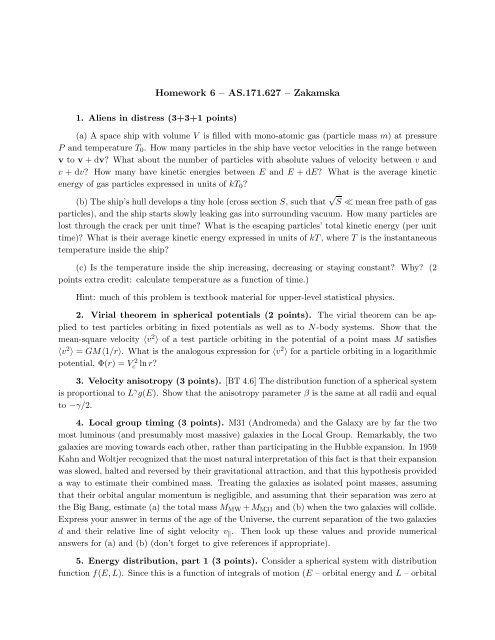Homework 6 â AS.171.627 â Zakamska
Homework 6 â AS.171.627 â Zakamska
Homework 6 â AS.171.627 â Zakamska
You also want an ePaper? Increase the reach of your titles
YUMPU automatically turns print PDFs into web optimized ePapers that Google loves.
<strong>Homework</strong> 6 – <strong>AS.171.627</strong> – <strong>Zakamska</strong><br />
1. Aliens in distress (3+3+1 points)<br />
(a) A space ship with volume V is filled with mono-atomic gas (particle mass m) at pressure<br />
P and temperature T 0 . How many particles in the ship have vector velocities in the range between<br />
v to v + dv? What about the number of particles with absolute values of velocity between v and<br />
v + dv? How many have kinetic energies between E and E + dE? What is the average kinetic<br />
energy of gas particles expressed in units of kT 0 ?<br />
(b) The ship’s hull develops a tiny hole (cross section S, such that √ S ≪ mean free path of gas<br />
particles), and the ship starts slowly leaking gas into surrounding vacuum. How many particles are<br />
lost through the crack per unit time? What is the escaping particles’ total kinetic energy (per unit<br />
time)? What is their average kinetic energy expressed in units of kT, where T is the instantaneous<br />
temperature inside the ship?<br />
(c) Is the temperature inside the ship increasing, decreasing or staying constant? Why? (2<br />
points extra credit: calculate temperature as a function of time.)<br />
Hint: much of this problem is textbook material for upper-level statistical physics.<br />
2. Virial theorem in spherical potentials (2 points). The virial theorem can be applied<br />
to test particles orbiting in fixed potentials as well as to N-body systems. Show that the<br />
mean-square velocity 〈v 2 〉 of a test particle orbiting in the potential of a point mass M satisfies<br />
〈v 2 〉 = GM〈1/r〉. What is the analogous expression for 〈v 2 〉 for a particle orbiting in a logarithmic<br />
potential, Φ(r) = Vc 2 ln r?<br />
3. Velocity anisotropy (3 points). [BT 4.6] The distribution function of a spherical system<br />
is proportional to L γ g(E). Show that the anisotropy parameter β is the same at all radii and equal<br />
to −γ/2.<br />
4. Local group timing (3 points). M31 (Andromeda) and the Galaxy are by far the two<br />
most luminous (and presumably most massive) galaxies in the Local Group. Remarkably, the two<br />
galaxies are moving towards each other, rather than participating in the Hubble expansion. In 1959<br />
Kahn and Woltjer recognized that the most natural interpretation of this fact is that their expansion<br />
was slowed, halted and reversed by their gravitational attraction, and that this hypothesis provided<br />
a way to estimate their combined mass. Treating the galaxies as isolated point masses, assuming<br />
that their orbital angular momentum is negligible, and assuming that their separation was zero at<br />
the Big Bang, estimate (a) the total mass M MW +M M31 and (b) when the two galaxies will collide.<br />
Express your answer in terms of the age of the Universe, the current separation of the two galaxies<br />
d and their relative line of sight velocity v ‖ . Then look up these values and provide numerical<br />
answers for (a) and (b) (don’t forget to give references if appropriate).<br />
5. Energy distribution, part 1 (3 points). Consider a spherical system with distribution<br />
function f(E,L). Since this is a function of integrals of motion (E – orbital energy and L – orbital
– 2 –<br />
angular momentum), it automatically satisfies the Boltzmann equation. Let N(E,L)dEdL be the<br />
number of stars in the range E to E + dE and L to L + dL. Find N(E,L) in terms of f(E,L).<br />
Hint: your answer should involve the radial period T r (E,L).<br />
6. Energy distribution, part 2 (2 points). Consider an equilibrium stellar system of N<br />
stars of mass m, where N ≫ 1, there is no mass in non-stellar components, and the graviational<br />
potential is Φ(x). The individual energy of a star at phase-space position (x i ,v i ) is ε i = m(vi 2/2 +<br />
Φ(x i )). Let E ′ = ∑ N<br />
i=1 ε i be the sum of individual energies. What is the relation of E ′ to the total<br />
energy of the system?<br />
7. Dynamical distance (3 points). The stars of a spherically symmetric cluster have<br />
mean-square proper motions relative to the cluster mean 〈µ 2 〉 and mean-square line-of-sight velocity<br />
relative to the mean 〈v‖ 2 〉. What is the cluster distance? Does this result depend on an assumption<br />
that the velocity ellipsoid is everywhere isotropic? This was the “dynamical distance” method used<br />
in Van de Ven et al. 2006 paper we discussed in class.

















